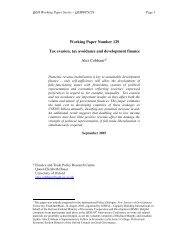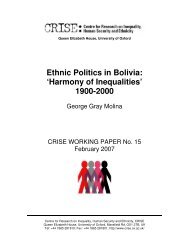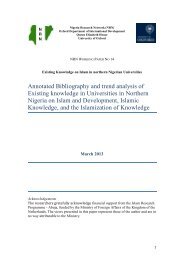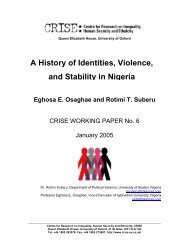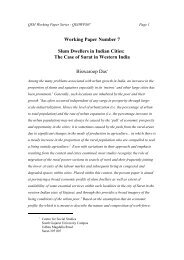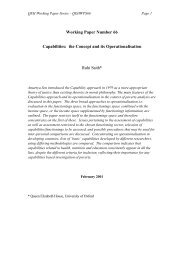Acute Multidimensional Poverty: A New Index for Developing ... - OPHI
Acute Multidimensional Poverty: A New Index for Developing ... - OPHI
Acute Multidimensional Poverty: A New Index for Developing ... - OPHI
You also want an ePaper? Increase the reach of your titles
YUMPU automatically turns print PDFs into web optimized ePapers that Google loves.
<strong>Acute</strong> <strong>Multidimensional</strong> <strong>Poverty</strong>: A <strong>New</strong> <strong>Index</strong> <strong>for</strong> <strong>Developing</strong> CountriesAlkire & Santospeople live in poor households which are deprived in electricity, improved sanitation, and cookingfuel; 30 percent are deprived of a safe source of drinking water; and 23 percent are deprived in assets(only the floor variable has a low headcount, 5 percent). Between 15 percent and 26 percent ofCambodians are poor and deprived in the education and health indicators. In Thailand and China,the highest contributor to overall poverty is deprivation in education. The headcounts, however, arevery low in general.5) Arab StatesThe Arab States constitute a highly heterogeneous group: the UAE, Occupied PalestinianTerritories, Jordan, Tunisia, Syria, and Egypt have MPI headcounts below 7 percent. Iraq hasan MPI-poor population of 14.2 percent. Morocco and Djibouti have an MPI-poor population of28 and 29 percent correspondingly, and the percentage in Yemen is 52 percent. In Somalia, the 6thpoorest country among the 104, 81 percent of people are poor, and they are deprived – on average –in 63 percent of the weighted indicators. In most of the Arab States, deprivation in education is thehighest contributor to poverty, but the headcounts are significant only in Djibouti and Morocco: 13percent of people in Djibouti and 18 percent in Morocco live in poor households where no onecompleted five years of education. The deprivation in terms of child school attendance reverses theorder: in Djibouti 18 percent of people are in poor households with children not attending schoolwhereas this is 15 percent in Morocco. In Jordan, Tunisia, and Yemen, the highest contributor topoverty is health deprivation, but headcounts are very low in the first two countries, whereas 34percent of people live in poor households that have experienced a child death in Yemen. InSomalia, the highest contributor of poverty is living standard: between 64 and 81 percent of thepopulation is deprived in some of these indicators.6) Europe and Eastern Europe and the Commonwealth of Independent States (CIS)In Europe and Central Asia the levels of poverty estimated with MPI are very low. In Slovenia andSlovakia the MPI is zero. In the Czech Republic and Belarus the MPI headcount is below 0.2percent whereas in Latvia, Kazakhstan, Hungary, Georgia, Bosnia and Herzegovina, Serbia, andAlbania, the MPI headcount is below 1 percent. In the Russian Federation, Montenegro, Croatia,Macedonia, Ukraine, Moldova, Armenia, and Uzbekistan, it ranges from 1.3 percent to 2.3 percent.In Kyrgyzstan and Azerbaijan it is about 5 percent. Estonia and Turkey show higher percentages ofMPI-poor people, 7.2 percent and 8.5 percent, respectively. Tajikistan is the poorest country in thisregion, with 17 percent poor people. We do not believe that the MPI will be able to guide policysignificantly in these countries; a different measure is required.4.4 Decompositions by state and ethnic group 65One of the strengths of the Alkire Foster methodology is that can be decomposed by populationsubgroup. Furthermore, it can be broken down by indicator to reveal the post-identificationcomposition of multidimensional poverty <strong>for</strong> different groups. This technical feature is oftremendous practical value <strong>for</strong> policy. Given the need to accelerate progress towards the MDGs, <strong>for</strong>example, it is vital to understand the composition of deprivations among different states and ethnicgroups, so that interventions address their particular deprivations most effectively. Naturally,decomposition is only possible when the data are representative by the relevant groups, so it was notpossible to decompose all 104 countries by any common factors other than rural-urban. However to65 We are very grateful to Suman Seth <strong>for</strong> per<strong>for</strong>ming the decomposition calculations in India, Kenya, and Bolivia.www.ophi.org.uk July 2010 48



